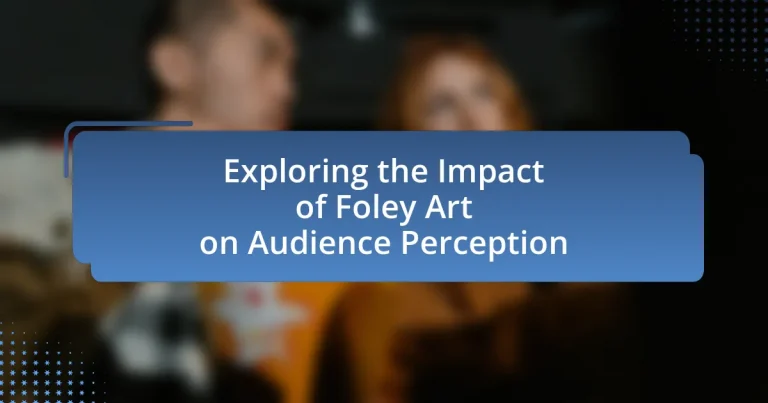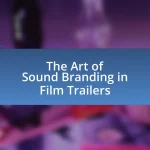Foley art is the process of creating and reproducing everyday sound effects in post-production to enhance the audio quality of films, thereby enriching the storytelling experience. This article explores the crucial role of Foley art in shaping audience perception by establishing mood, emphasizing actions, and providing realism through specific sound effects like footsteps and ambient noises. It discusses how sound influences emotional responses, the techniques used by Foley artists, and the impact of technological advancements on sound design. Additionally, the article addresses common misconceptions about Foley art and highlights its significance in various film genres, ultimately demonstrating how understanding Foley can enhance audience appreciation of cinematic experiences.
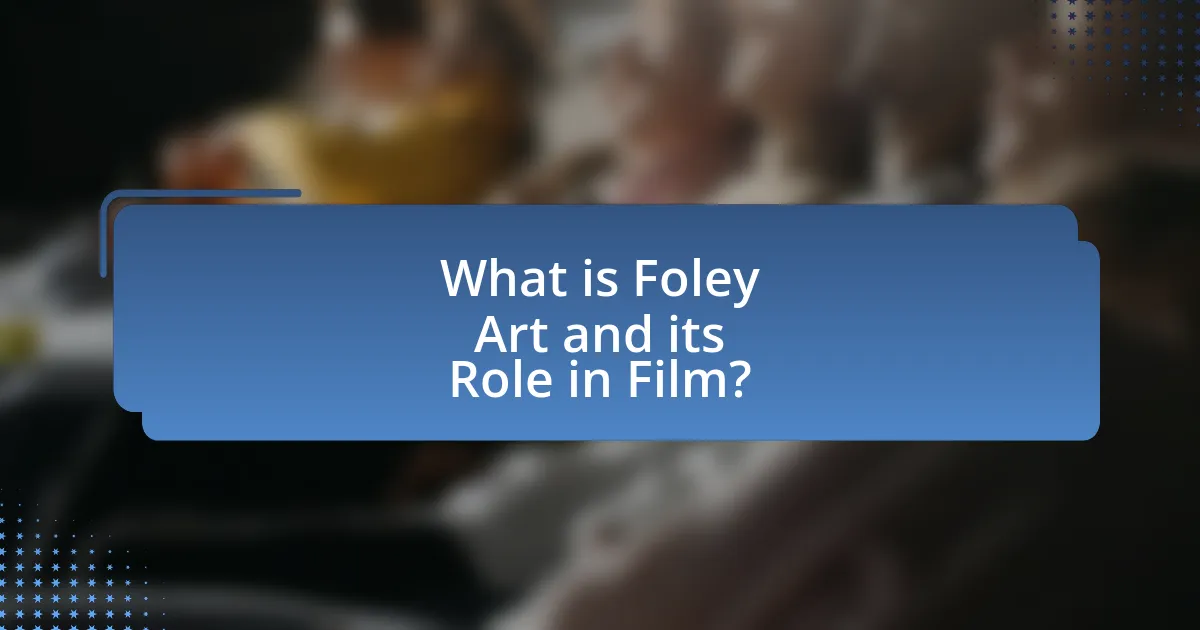
What is Foley Art and its Role in Film?
Foley art is the reproduction of everyday sound effects that are added to films in post-production to enhance audio quality and create a more immersive experience. This technique involves recording sounds such as footsteps, rustling clothes, and ambient noises to match the visual elements on screen, thereby enriching the storytelling. The role of Foley art in film is crucial as it helps to establish mood, emphasize actions, and provide realism, ultimately influencing audience perception by making scenes more relatable and engaging. For instance, a study by the University of Southern California found that well-executed Foley can significantly enhance emotional responses in viewers, demonstrating its impact on audience engagement and perception.
How does Foley Art enhance the cinematic experience?
Foley Art enhances the cinematic experience by creating realistic sound effects that immerse the audience in the film’s environment. This technique involves recording everyday sounds, such as footsteps or rustling clothes, to synchronize with the visuals, thereby enriching the storytelling. Research indicates that sound significantly influences emotional responses; for instance, a study published in the Journal of Experimental Psychology found that sound effects can enhance the perception of realism and emotional engagement in film. By providing a more authentic auditory backdrop, Foley Art deepens the viewer’s connection to the narrative and characters, ultimately elevating the overall cinematic experience.
What specific sounds are created through Foley Art?
Foley Art creates specific sounds such as footsteps, rustling clothing, breaking glass, and ambient noises like wind or rain. These sounds are produced by recording real-life actions and objects to enhance the auditory experience in film and television. For instance, footsteps can be mimicked using various surfaces like gravel or wood, while breaking glass can be simulated with actual glass or other materials to achieve the desired effect. This meticulous process adds realism and depth to the audio landscape, significantly influencing audience perception and immersion in the narrative.
How do these sounds contribute to storytelling in film?
Sounds in film, particularly Foley sounds, significantly enhance storytelling by creating a more immersive experience for the audience. These sounds provide context, evoke emotions, and establish realism, which helps viewers connect with the narrative on a deeper level. For instance, the sound of footsteps can indicate a character’s mood or urgency, while ambient sounds can set the scene’s atmosphere, influencing how the audience perceives the unfolding story. Research shows that well-executed Foley can increase audience engagement and emotional response, as evidenced by studies indicating that films with high-quality sound design often receive better ratings and viewer satisfaction.
Why is Foley Art important for audience perception?
Foley Art is important for audience perception because it enhances the realism and emotional engagement of a film or audio production. By creating specific sound effects that match the visual elements, Foley Art helps to immerse the audience in the narrative, making the experience more believable and relatable. Studies have shown that well-executed Foley can significantly influence how viewers interpret scenes, as sound is a critical component of storytelling; for instance, a study published in the Journal of Media Psychology found that audiences rated films with high-quality Foley as more engaging and emotionally impactful compared to those without. This demonstrates that Foley Art is essential in shaping audience reactions and perceptions.
How does sound influence emotional responses in viewers?
Sound significantly influences emotional responses in viewers by evoking feelings and enhancing the narrative experience. Research indicates that specific sound elements, such as music and sound effects, can trigger emotional reactions, with studies showing that minor changes in sound can alter a viewer’s perception of a scene. For instance, a study published in the journal “Psychology of Music” by Brattico et al. (2013) found that consonant harmonies elicit positive emotions, while dissonant sounds can induce feelings of tension or discomfort. This demonstrates that sound is a powerful tool in shaping emotional engagement and audience perception in visual media.
What psychological effects does Foley Art have on audience engagement?
Foley Art significantly enhances audience engagement by creating a more immersive and realistic auditory experience. This heightened realism can evoke emotional responses, increase suspense, and enhance the overall narrative, making viewers feel more connected to the story. Research indicates that sound effects can trigger specific psychological reactions; for instance, a study published in the Journal of Experimental Psychology found that synchronized sound effects can amplify emotional responses to visual stimuli, leading to greater audience involvement. Thus, Foley Art plays a crucial role in shaping how audiences perceive and engage with visual media.
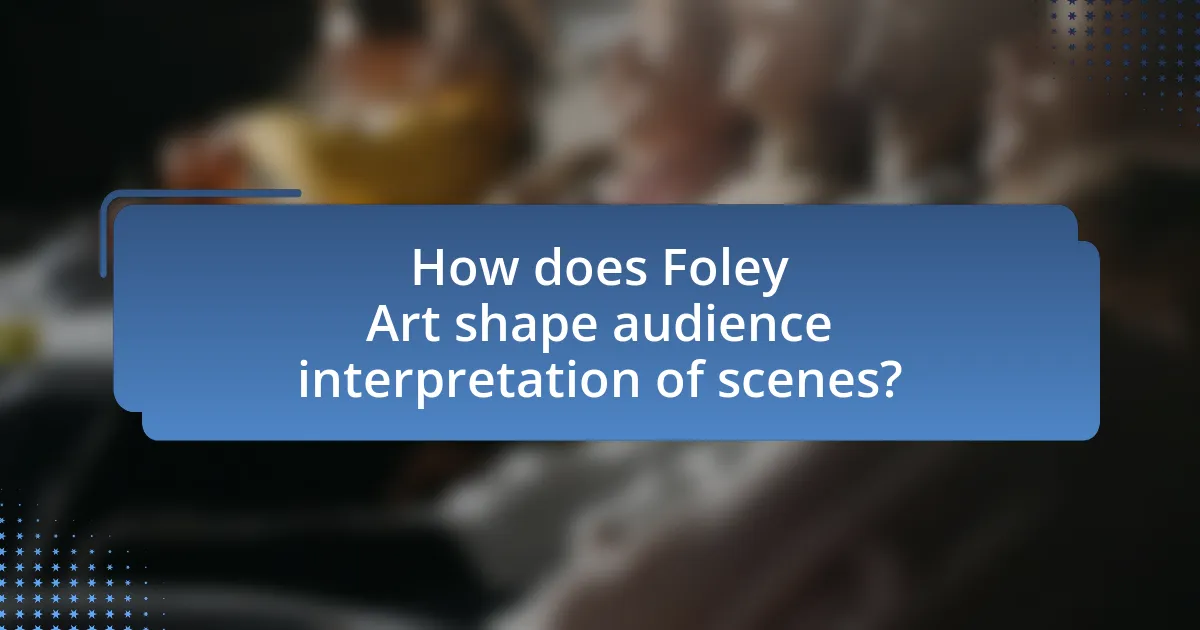
How does Foley Art shape audience interpretation of scenes?
Foley Art significantly shapes audience interpretation of scenes by enhancing the emotional and contextual depth of the narrative. This auditory technique involves creating sound effects that align with the visual elements, thereby influencing how viewers perceive actions and emotions. For instance, the sound of footsteps on gravel can evoke a sense of tension or urgency, guiding the audience’s emotional response to the scene. Research indicates that well-executed Foley can increase audience engagement and immersion, as demonstrated in films like “A Quiet Place,” where sound design plays a crucial role in building suspense. Thus, Foley Art not only complements visuals but also actively shapes the audience’s understanding and emotional experience of the story.
What techniques do Foley artists use to create immersive soundscapes?
Foley artists use a variety of techniques to create immersive soundscapes, including the use of props, recording environments, and synchronization with visual elements. They often utilize everyday objects to replicate sounds, such as using shoes on different surfaces to mimic footsteps or crumpling paper to simulate the sound of rustling leaves. Additionally, Foley artists record sounds in controlled environments to capture high-quality audio that matches the scene’s ambiance. They meticulously synchronize these sounds with the visual elements of a film or video, ensuring that the audio enhances the viewer’s experience and perception. This process is crucial, as studies have shown that well-executed Foley can significantly impact audience engagement and emotional response, reinforcing the narrative and atmosphere of the visual content.
How do these techniques affect the realism of a film?
Foley techniques significantly enhance the realism of a film by creating immersive soundscapes that align with visual elements. These techniques, such as the reproduction of everyday sounds like footsteps or rustling clothing, contribute to the authenticity of the viewing experience. Research indicates that well-executed Foley art can evoke emotional responses and increase audience engagement, as demonstrated in films like “A Quiet Place,” where sound design plays a crucial role in storytelling. The integration of Foley sounds helps to ground the narrative in reality, making the film more relatable and believable for viewers.
What role does timing play in the effectiveness of Foley Art?
Timing is crucial in the effectiveness of Foley Art as it directly influences the synchronization of sound effects with visual elements, enhancing the overall immersive experience for the audience. Precise timing ensures that sounds, such as footsteps or environmental noises, align perfectly with the actions on screen, creating a believable and engaging atmosphere. Research indicates that when Foley sounds are accurately timed, audience engagement and emotional response are significantly heightened, as evidenced by studies showing that viewers are more likely to feel a connection to the narrative when auditory cues match visual stimuli.
How does Foley Art differ across genres?
Foley art differs across genres primarily in the types of sounds created and their contextual relevance to the narrative. In action films, for instance, Foley artists focus on creating intense, dynamic sounds like explosions and footsteps on various surfaces to enhance the adrenaline of the scenes. Conversely, in romantic comedies, the emphasis is on softer, more intimate sounds, such as the rustling of clothing or gentle background noises that support the emotional tone. This genre-specific approach is crucial because it directly influences audience perception; research indicates that sound design significantly affects emotional engagement and immersion in a film (Bregman, 1990). Thus, the distinct soundscapes crafted in Foley art are tailored to evoke specific responses aligned with the genre’s thematic elements.
What unique challenges do Foley artists face in different film genres?
Foley artists face unique challenges in different film genres due to the varying sound requirements and audience expectations. In action films, for instance, Foley artists must create intense, high-energy sounds that match fast-paced visuals, often requiring innovative techniques to replicate sounds like explosions or high-speed chases. Conversely, in horror films, the challenge lies in crafting subtle, eerie sounds that enhance tension and evoke fear, necessitating a focus on atmospheric audio rather than overt sound effects. Additionally, in romantic comedies, Foley artists must capture intimate sounds, such as soft footsteps or gentle touches, to convey emotional nuances, which demands a delicate approach to sound design. Each genre’s distinct auditory landscape requires Foley artists to adapt their methods and creativity to effectively support the film’s narrative and enhance audience engagement.
How does audience expectation vary by genre regarding sound design?
Audience expectation regarding sound design varies significantly by genre, as each genre establishes distinct auditory conventions that shape listener experiences. For instance, in horror films, audiences anticipate unsettling soundscapes that enhance tension and fear, often utilizing sudden loud noises or eerie ambient sounds to evoke emotional responses. Conversely, in romantic comedies, sound design typically emphasizes light, whimsical music and naturalistic dialogue to create a warm, inviting atmosphere. This variance is supported by studies indicating that genre-specific sound cues can influence emotional engagement; for example, research published in the Journal of Experimental Psychology shows that horror sound design effectively heightens anxiety levels in viewers, while uplifting scores in comedies promote feelings of joy and connection. Thus, audience expectations are closely tied to the established norms of each genre’s sound design.
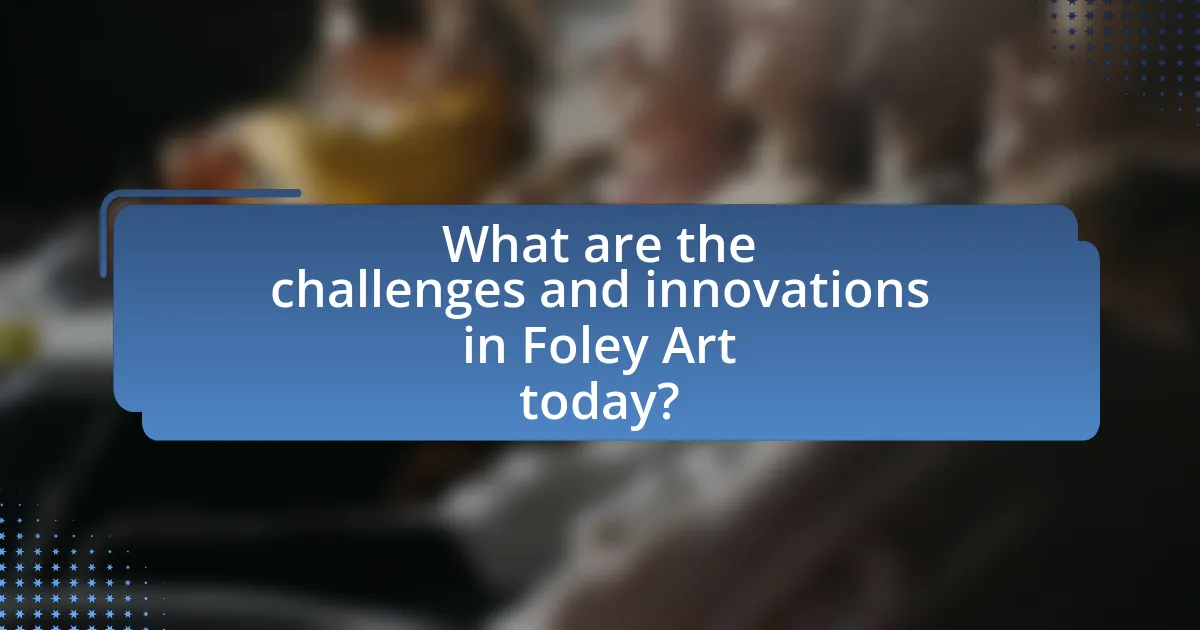
What are the challenges and innovations in Foley Art today?
The challenges in Foley Art today include the increasing demand for high-quality sound effects in a competitive industry and the need for artists to adapt to rapidly evolving technology. Innovations in this field involve the use of advanced digital tools and software that enhance sound creation and manipulation, allowing Foley artists to produce more realistic and immersive audio experiences. For instance, the integration of virtual reality (VR) and augmented reality (AR) technologies has transformed how Foley is created, enabling artists to simulate soundscapes in three-dimensional environments. These advancements not only improve the quality of sound but also expand the creative possibilities for storytelling in film and media.
How has technology impacted the practice of Foley Art?
Technology has significantly transformed the practice of Foley Art by enhancing sound quality and expanding creative possibilities. The introduction of digital audio workstations (DAWs) allows Foley artists to record, edit, and manipulate sounds with precision, resulting in higher fidelity audio that can be seamlessly integrated into film and television. Additionally, advancements in recording equipment, such as high-definition microphones and portable recording devices, enable Foley artists to capture a wider range of sounds in various environments, improving the authenticity of sound effects. Furthermore, software tools for sound design and effects processing have broadened the creative scope, allowing for innovative soundscapes that enhance audience engagement and perception.
What new tools and techniques are being adopted by Foley artists?
Foley artists are adopting advanced digital audio workstations (DAWs) and virtual reality (VR) technology to enhance their craft. The integration of DAWs allows for more precise sound manipulation and layering, while VR technology enables Foley artists to create immersive soundscapes that align with 3D environments, enhancing audience engagement. Additionally, the use of high-fidelity microphones and portable recording devices has become prevalent, allowing for greater flexibility and quality in capturing sounds in various settings. These tools and techniques reflect the evolving landscape of sound design, aiming to create a more impactful auditory experience for viewers.
How do these innovations enhance audience perception?
Innovations in Foley art enhance audience perception by creating a more immersive and realistic auditory experience. These advancements, such as the use of high-definition recording techniques and advanced sound manipulation software, allow for precise synchronization of sound effects with visual elements, making scenes more believable. For instance, a study by the University of Southern California found that audiences rated films with high-quality Foley sound as more engaging and emotionally impactful compared to those with lower sound quality. This demonstrates that enhanced sound design directly influences how audiences connect with and interpret visual narratives.
What are the common misconceptions about Foley Art?
Common misconceptions about Foley Art include the belief that it solely involves creating sound effects in post-production, while in reality, Foley artists also enhance the emotional and narrative aspects of a film through sound. Additionally, many think that Foley is merely about mimicking sounds, but it actually requires a deep understanding of the context and timing to match the visuals effectively. Another misconception is that Foley work is easy and can be done quickly; however, it often involves meticulous attention to detail and can take significant time to achieve the desired results. These misconceptions can undermine the appreciation of Foley Art’s complexity and its crucial role in shaping audience perception.
Why do some people underestimate the importance of sound in film?
Some people underestimate the importance of sound in film because they primarily focus on visual elements, neglecting how sound enhances storytelling and emotional engagement. Research indicates that sound design, including Foley art, significantly influences audience perception and immersion, often subconsciously affecting their emotional responses. For instance, a study published in the Journal of Film and Video found that films with well-executed sound design received higher ratings for emotional impact compared to those with poor sound quality, demonstrating that sound is crucial for creating a compelling cinematic experience.
How can understanding Foley Art improve audience appreciation of films?
Understanding Foley Art enhances audience appreciation of films by deepening their awareness of sound design’s role in storytelling. When viewers recognize the meticulous process behind Foley Art, such as the creation of realistic sound effects that complement visual elements, they become more engaged with the film’s atmosphere and emotional depth. Research indicates that sound significantly influences viewer perception; for instance, a study published in the Journal of Experimental Psychology found that sound effects can alter emotional responses to visual stimuli. This connection between sound and emotion underscores the importance of Foley Art in crafting immersive cinematic experiences, ultimately leading to a greater appreciation of the film as a whole.
What practical tips can enhance the understanding of Foley Art’s impact?
To enhance the understanding of Foley Art’s impact, one practical tip is to analyze specific scenes in films where Foley sounds are prominently used. This analysis allows audiences to recognize how sound effects contribute to emotional responses and narrative depth. For instance, in the film “A Quiet Place,” the use of Foley to create tension through subtle sound effects significantly influences viewer engagement and fear levels. By studying such examples, audiences can better appreciate the artistry and technical skill involved in Foley production, thereby deepening their understanding of its role in shaping audience perception.
